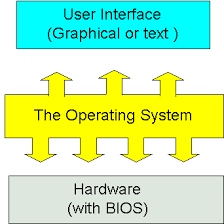What is Operating system?
An operating system (OS) is a software that manages computer hardware resources and provides common services for computer programs. The OS acts as a mediator between the hardware and the software components of a computer system, enabling them to communicate and work together. It also provides the interface between the user and the computer, allowing users to interact with the system and control its behavior.
The basic functions of an operating system include managing computer resources, such as memory and processing power, controlling input and output operations, providing security features, managing network connections, and facilitating communication between different software programs. The operating system is also responsible for scheduling tasks and managing system resources efficiently to maximize performance.
There are several types of operating systems, including single-user, multi-user, real-time, and embedded systems. Single-user operating systems are designed for use by a single user, such as personal computers, while multi-user operating systems are designed to support multiple users, such as servers. Real-time operating systems are used in applications that require rapid and precise responses to external events, such as in industrial control systems or military applications. Embedded systems are used in devices such as smartphones, televisions, and automobiles, and are designed to provide specific functionality in a compact and efficient manner.
The development of operating systems has evolved over time, with each generation introducing new features and capabilities. The first generation of operating systems, developed in the 1950s and 1960s, were simple batch processing systems that executed programs in sequence. The second generation of operating systems, developed in the 1960s and 1970s, introduced the concept of time-sharing, enabling multiple users to access a computer system simultaneously. This led to the development of multi-user operating systems such as Unix and its variants, which are still widely used today.
The third generation of operating systems, developed in the 1980s and 1990s, introduced graphical user interfaces (GUIs) and integrated networking capabilities. This enabled users to interact with the computer using a mouse and graphical elements such as icons and windows. The fourth generation of operating systems, which emerged in the 2000s, introduced features such as virtualization and cloud computing, allowing for greater flexibility and scalability in computing resources.
Operating systems also play a crucial role in computer security, providing features such as authentication, authorization, and access control to protect against unauthorized access and malicious software. Modern operating systems use a variety of security features such as firewalls, antivirus software, and encryption to ensure the integrity and confidentiality of data.
In addition to their primary functions, operating systems also provide a platform for the development and execution of software applications. Developers can use operating system APIs (Application Programming Interfaces) to access system resources such as file systems, input/output devices, and network connections. This allows software developers to create applications that can run on a variety of different operating systems, increasing their reach and versatility.
The most widely used operating systems today are Microsoft Windows, Apple's macOS, and various Linux distributions. Windows dominates the market share of desktop and laptop computers, while macOS is commonly used on Apple's Macintosh computers. Linux is a free and open-source operating system that is widely used in servers and other computing systems due to its stability, security, and flexibility.
Overall, operating systems are a fundamental component of modern computer systems, providing the foundation for the software applications and services that we rely on every day. As technology continues to advance, operating systems will continue to evolve and adapt to new challenges, providing users with ever-increasing capabilities and functionality.










comment here guys
ReplyDelete